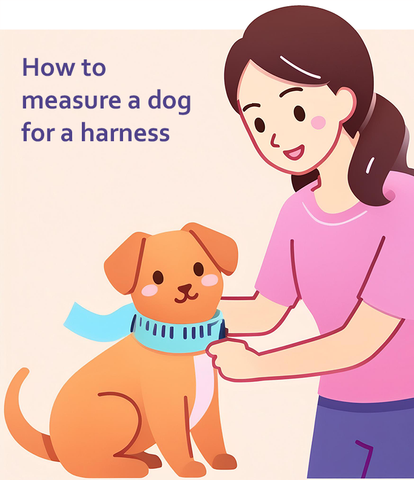
Choosing the right harness for your dog is crucial for their comfort and safety during walks or adventures. A well-fitted harness not only prevents discomfort but also ensures that your pup stays secure and happy. So how do you measure your dog for a harness? Don't worry; it's easier than you think. Follow these simple steps to get the perfect fit for your canine companion.
Why the Right Fit Matters
Before showing the measuring process, let's understand why the right fit is so important. A properly fitting harness:
- Prevents chafing and discomfort: a harness that's too tight can rub against your dog's skin, causing chafing and irritation. On the other hand, a harness that's too loose may cause your dog to wiggle out or become tangled.
- Improves control: a snug harness ensures that you have good control over your dog, especially if they tend to pull during walks.
- Reduces the risk of injury: a properly fitted harness distributes pressure evenly across your dog's body, reducing the risk of strain or injury to their neck and throat.
Now that we understand the importance, let's move on to the fun part – measuring your pup.
What You'll Need
- A soft tape measure (or a ruler and string)
- Treats to keep your furry friend motivated

Step-by-Step Guide
- Measure the neck: start by measuring around the base of your dog's neck, where their collar usually sits. Make sure the tape measure is snug but not too tight. This measurement will help determine the size of the harness's neck opening.
- Measure the chest: next, measure around the widest part of your dog's chest, just behind their front legs. Again, keep the tape measure snug for an accurate measurement. This measurement will determine the size of the harness's chest strap.
- Record both measurements. If you're using a string and ruler, mark the length of the string and then measure it against the ruler.
- Choose the right size: refer to the harness sizing guide. Match your dog's measurements with the recommended size to ensure a proper fit. If your dog's measurements fall between sizes, opt for the larger size.
- Try it on: once you've selected the appropriate sized harness, put it on your dog and adjust the straps to achieve a snug but comfortable fit. You should be able to fit two fingers between the harness and your dog's body.
- Test for movement: with the harness properly fitted, gently tug on the straps to ensure they're secure. Your dog should be able to move freely without any restrictions.
- Reward and reassure: throughout the process, offer plenty of praise and treats to make the experience positive for your pup. This will help them associate wearing the harness with positive feelings.
Final Thoughts
Measuring your dog for a harness doesn't have to be complicated. By following these simple steps and ensuring a proper fit, you'll set your dog up for comfortable and safe adventures. Remember, the right harness can make all the difference in your dog's comfort and enjoyment during walks and outdoor activities.
This is how we measure:
Our size chart:
| Size | Neck | Chest Girth |
| M |
12” - 14” (30cm - 36cm) |
17” - 23” (43cm - 58cm) |
| L |
14” - 16” (36cm - 41cm) |
20” - 28” (51cm - 71cm) |
| XL |
16” - 18” (41cm - 46cm) |
23” - 32” (58cm - 81cm) |
